Recreating the Country blog |
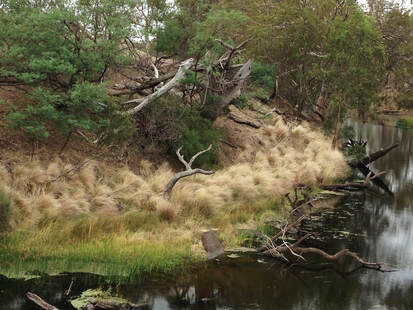 Feathery clumps of Silver Tussock Grass softly reinforcing a fragile river bank. The Silver Wattle behind completes this natural scene. Photo taken on the Barwon River near Geelong Feathery clumps of Silver Tussock Grass softly reinforcing a fragile river bank. The Silver Wattle behind completes this natural scene. Photo taken on the Barwon River near Geelong Blackwood, Acacia melanoxylon Riparian Wattles – think black, think silver and think swamp. Victoria’s waterways are great places to visit. Whether they are wide flowing rivers or small dry creek beds they are exhilarating to explore. Here are some snapshots of my own memories of walks along river/creek banks;
The edges of our creeks and rivers are where you will find plants that are unique to moist environments. These are plants that have adapted to wet feet during times of flooding and to extreme dry seasons a few months later. They deserve our admiration because they somehow thrive in spite of these dramatic climate contrasts. 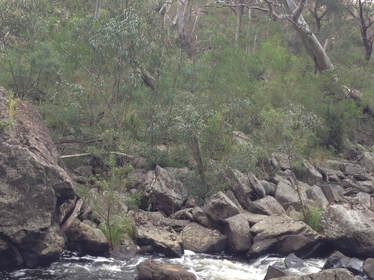 The Moorabool River rocky landscape is where you will discover rare plants. The Moorabool River rocky landscape is where you will discover rare plants. Three remarkable riparian wattles There are three remarkable wattles that grow on waterways that I regularly visited on seed collecting expeditions and they’re easy to remember - think black, think silver and think swamp. The Blackwood and the Silver Wattle, Acacia dealbata are often found sharing a river bank. You can see them together at Morrisons on the Moorabool River 7km north of Meredith in central Victoria. In this deep and mysterious valley they grow on the river flat and provide the understorey and tall shrub layers under a canopy of River Red Gums. The Swamp Wattle, Acacia retinodes forms a low shrub layer under River Red Gums at the very pretty Pitfield’s reserve on the Woady Yallock River, 15km NW of Rokewood. These wattles illustrate how nature builds structural layering into vegetation, a critically important strategy to maximise safe habitat for wildlife. Click here and scroll down to read about structural layering in vegetation The tallest of this trio is the Blackwood, Acacia melanoxylon; Commonly pronounced melon-ox-a-lon It’s all Greek – melas = black; xylon = wood. Literally it translates as ‘black wood’ and it describes the deep brown/black colour of the heart wood of mature trees. The outer layer of the heartwood is called the xylem. This is where water is carried from the roots, up the trunk to the leaves. Tall trees like the taller Blackwoods have a long way to lift water from their roots to nourish the leaves and new growth. Some Human context 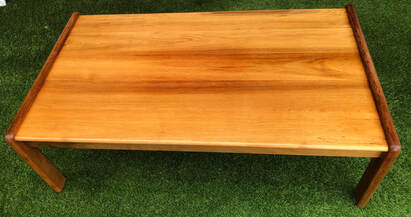 Blackwood coffee table showing a variety of rich colours. The darker heartwood can be seen on the legs Blackwood coffee table showing a variety of rich colours. The darker heartwood can be seen on the legs The adaptable Blackwood The Blackwood has a very wide distribution from northern Queensland right down the east coast to Tasmania. It also occurs naturally in the Mt Lofty region of SA. It is a hardy, dense, strong, long lived wattle that makes an excellent fire retarding windbreak on farms. Its best suited to moist soils and damp gullies. Choosing the right provenance for your planting is important because they vary greatly in drought tolerance and size, from forest giants to bushy tall shrubs (see below). Ideally choose Blackwoods indigenous to the planting site as they will be well adapted to the local climate and soil. Blackwood’s are well known for producing a hard, dense timber for making beautiful furniture, benchtops, cupboard doors and veneers. It is described as one of the world's finest furniture timbers. The timber most suitable for cabinetry is usually harvested from Blackwood’s growing in higher rainfall areas where the trees grow tall and straight. In the wet forests of the Otway Ranges and Tasmania, Blackwood’s live well over 150 years and can grow into 30m tall forest giants. In lower rainfall well drained soils and moist gullies, Blackwood’s may live up to 100 years and are a much smaller tree (10m – 12m). They have closer growth rings and are prized for making personalised furniture. Blackwood’s growing in low rainfall dry woodland areas along waterways grow to a similar size and age. The Morrison's Blackwoods described above fit into this category. This medium sized form is ideal as a street tree because it is strong, dense, shady and long lived. It has the added advantage of needing very little maintenance. There are also smaller Blackwood’s that have adapted to the heavy soils and exposure to the climate extremes of the basalt plains. These trees have a hard life, live up to 25 years and reach 5 – 7m tall. They’re gnarly wood is prized for craft work. Wood-workers take care Blackwood saw-dust is a recognised lung, eye and skin irritant. I met a cabinet maker near Portland who had a small shed full of dried and numbered Blackwood planks that he was keen to sell. He had harvested the logs himself from trees that had been cut down under powerlines on a nearby roadside. The logs had been slabbed and were ready for use in his workshop. Sadly he found that the saw-dust from the Blackwood irritated his normally healthy lungs causing asthma, even when he worked with a dust extractor. 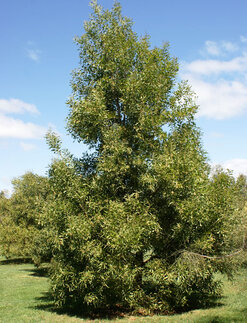 Blackwood planted as a paddock tree has many advantages. Photo Victorian Native Seed Blackwood planted as a paddock tree has many advantages. Photo Victorian Native Seed The perfect paddock tree - the benefit of clumps The hardiness and longevity of the Blackwood makes it an ideal paddock tree. It also hosts nitrogen-fixing Rhizobium bacteria (like all wattles) that improve soil fertility. This benefits surrounding trees, crops and native grasslands. Its tough bark is resistant to damage from stock and the trees provide excellent shade. To hasten the development of significant habitat for wildlife as well as excellent shelter for stock, plant new paddock trees in groups of five with a spacing of 3 – 5 metres between each tree. Group planting like this multiplies and accelerates the ecological services these new paddock trees provide. The tree clump will have many of the benefits of a single 50 – 75 year old mature tree in only 10 – 15 years. When these Blackwood's mature beyond 15 years some can be thinned for their valuable timber to make room for the remaining trees to develop a more robust form. 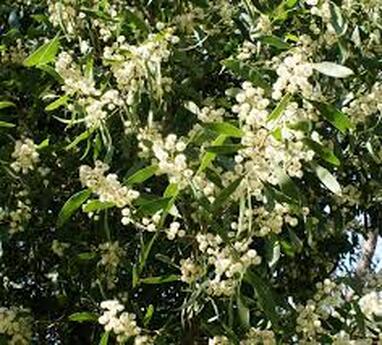 Pale yellow/white flowers on a Blackwood Pale yellow/white flowers on a Blackwood Nature notes The Blackwood’s pale yellow to white flowers grow in clusters and appear from September – November in the southern states and November – March in Queensland. In south-east Queensland the Blackwood supports many native butterfly larvae - the tailed emperor, silky hairstreak, imperial hairstreak, stencilled hairstreak and large grass-yellow butterflies. Its dense foliage also provides shelter for many birds. It offers protected nesting areas and produces copious quantities of seed. This seed is popular food for Cockatoos, Rosellas, Wattlebirds, various honeyeaters, King Parrot and the Bronzewing Pidgeon. Ants also harvest Blackwood seed for the oil rich aril and take the seeds underground where they will remain viable for centuries Small birds like the Grey Fantail and Superb Fairy Wren glean insects from Blackwood leaves. 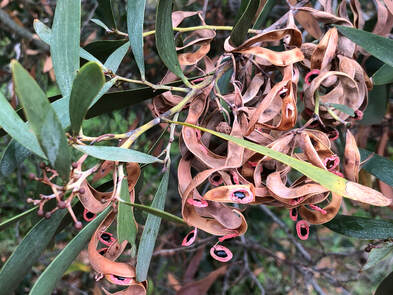 Blackwood seed and pods showing the orange coloured aril around the black seed Blackwood seed and pods showing the orange coloured aril around the black seed The glands at the base of the Blackwood leaves (phyllodes) produce a sugary sap during flowering that attracts a variety of birds including silvereyes, honeyeaters, treecreepers, spinebills and thornbills. This entices them to the tree to help with pollination. Sugar Gliders also harvest the nourishing protein rich sap by wounding the trunk to encourage it to bleed. The Gliders defend the Blackwoods within their territory from other families of Sugar Gliders. Sugar Gliders also feed on the sap of Black Wattle, Acacia mearnsii, Silver Wattle and Lightwood, Acacia implexa 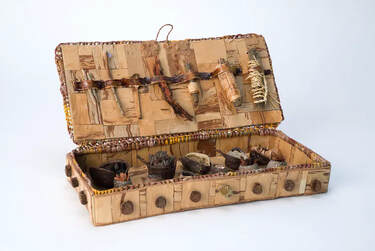 Yorta Yorta bush medicine first aid kit. The Conversation, June 2018. Click on the image to read the article by Beth Gott, 'The art of healing - five medicinal plants used by Aboriginal Australians' Yorta Yorta bush medicine first aid kit. The Conversation, June 2018. Click on the image to read the article by Beth Gott, 'The art of healing - five medicinal plants used by Aboriginal Australians' First Australians Blackwood has a rich history of use by indigenous Australians; The bark of the Blackwood is soaked in hot water to produce an analgesic solution. This will ease pain when rubbed into sore muscles or used to bathe painful rheumatic joints. The leaves have been used as a natural soap. Take some fresh leaves, add a little water and rub hands together vigorously until the foam forming saponins are released. These natural chemicals will clean your hands. Blackwood twigs and bark were used to stun fish, making them easy to catch. The thick sap from the trunk was used as an adhesive to join pieces of Blackwood to craft strong weapons and tools. These include spear-throwers, boomerangs, clubs and shields. The inner bark was used to make a strong string. 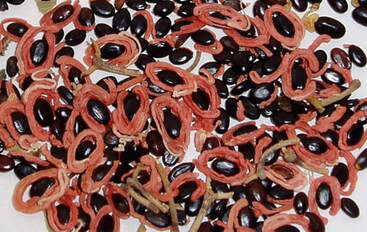 A mixture of Blackwood seeds with and without the attached aril A mixture of Blackwood seeds with and without the attached aril Propagation Caution – Cleaning Blackwood seed creates a fine dust that is very irritating to the lungs. Like other wattles, Blackwoods are easy to gerninate from seed using the boiled water treatment described at the end of the ‘Black Wattle’ story. The seed is very distinctive as it is encircled by an orange aril. It is also very convenient to collect as it often hangs on trees for months with the seed-pods fully open as if advertising its availability. Refer to a section at the end of 'Acacias' for a simple method of inoculating wattle seedlings for more vigorous and healthy trees. Removing the aril I have found that Blackwood seed is easier to treat and to sow if the aril is removed. After the seed is separated from the pods most of the arils will still be attached. To remove them, wearing leather gloves and a dust mask, rub the seeds vigorously between your hands until most of the arils are dislodged. Winnow the seed pouring it from bucket to bucket in a light breeze. The lighter arils will blow to the side leaving the cleaned seeds ready to package in a Zip-lock bag. Remember to record the species name, collected location and the date of collection on the bag for future reference. Other valuable information to record; tree size, soil type, drainage, exposure and the number of plants in the seed collection sample as a guide to its genetic diversity. Next month; Paddock trees: benefits on farms Silver Wattle, A. dealbata
9 Comments
Terry Laybourne
20/10/2020 09:29:55 pm
We suffered tremendously as a result of the bushfires early this year. Virtually all the bush that is on our 5Ha property was severely burnt. Most of the wattles have failed to survive and many of the eucalyptus trees have had a hard time recovering. Fortunately, the bush has a way of regenerating and we now see many Wattles emerging as the pioneer plants as well as most of the gums sprouting vigorously. We have taken to repositioning many of the newly germinated gums to areas that are barren. Long live the trees!
Reply
Steve
25/10/2020 12:49:36 pm
Hi Terry,
Reply
Terry Laybourne
26/10/2020 09:00:09 am
G'day Steve, thanks for your response. I have now gone to your site to see what trees I need to get. I find it hard to "cull" plants that are growing. I have often dug young seedlings up and relocated them to areas where I think they will prosper and add to the environment. I have found that wattles don't respond too kindly to shifting! Thanks again for your website.
Reply
Steve
28/10/2020 06:03:56 pm
Hi Terry, 5/7/2021 08:25:59 am
Hi Steve,
Reply
Steve
6/7/2021 12:29:27 pm
Hi Brad,
Reply
Claude Serreyn
24/3/2023 05:22:01 pm
Hi Steve - I have a couple of mature blackwood trees growing on the narrow dirt strip between the roadway and the footpath in country town SA. Totally out of place and I suspect roots feeding off the municipal sewage system - these trees are huge. The problem is the roots are invasive and around March each year multiple tree growths appear in many places all over the front yard ! I manage to destroy these " budding growths " with repeated applications of ZERO weed spray but I am looking for a more effective and permanent solution. Any advice much appreciated - kind regards :)
Reply
Viv
13/4/2024 05:32:26 pm
Can you direct me to more information about the sap of Blackwood containing protein ??
Reply
Leave a Reply. |
Click on the image below to discover 'Recreating the Country' the book.
Stephen Murphy is an author, an ecologist and a nurseryman. He has been a designer of natural landscapes for over 30 years. He loves the bush, supports Landcare and is a volunteer helping to conserve local reserves.
He continues to write about ecology, natural history and sustainable biorich landscape design. 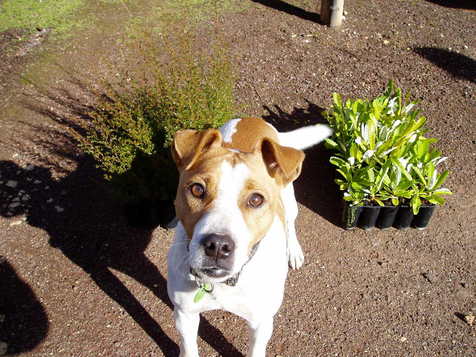
|
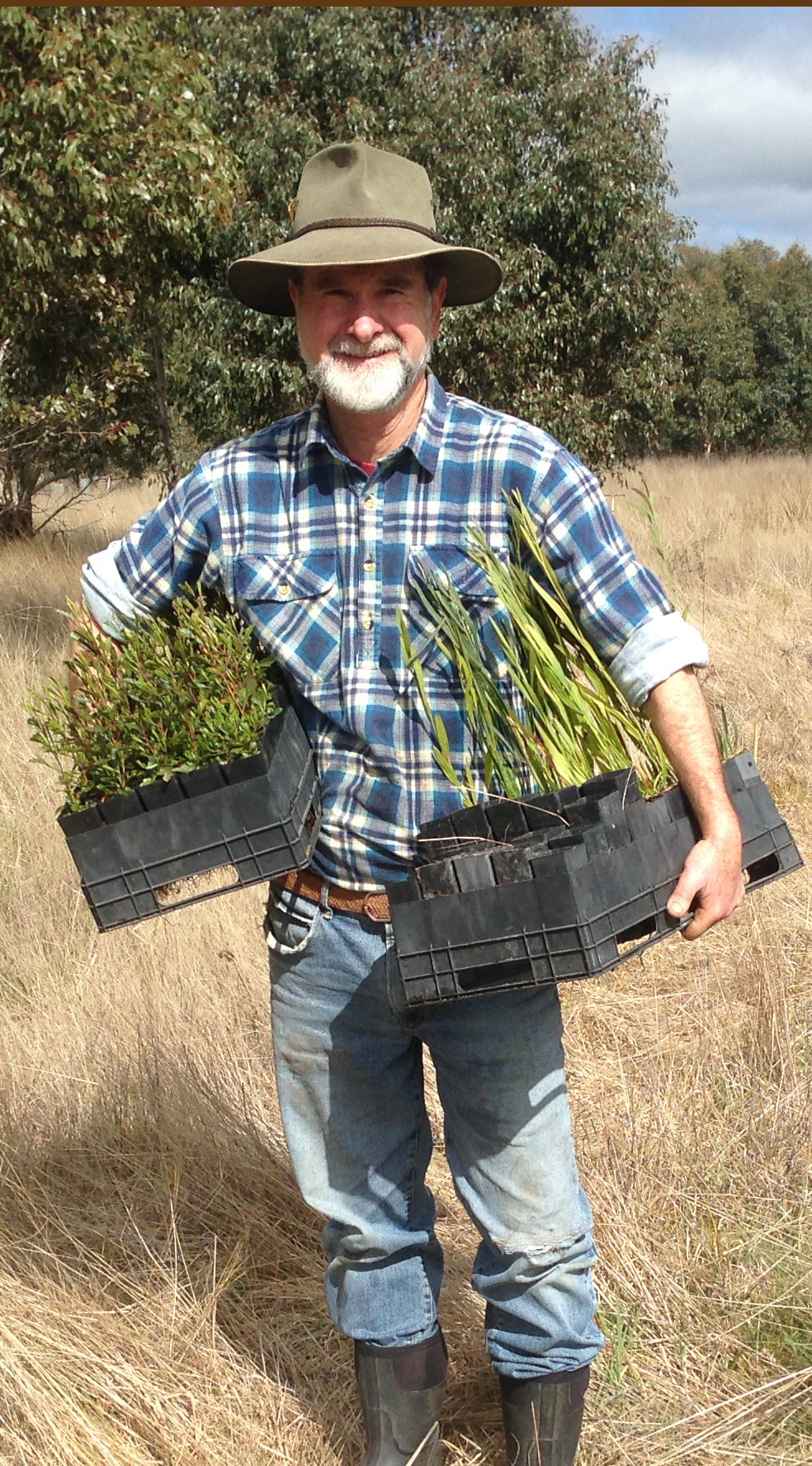

 RSS Feed
RSS Feed
